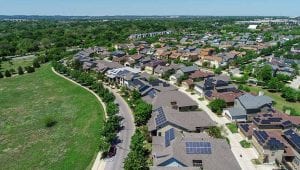The Australian Renewable Energy Agency has again stressed just how rapidly and thoroughly it expects battery storage to change the shape of Australia’s electricity market, and what networks should be doing to prepare for – and capitalise on – this shift, in an op-ed written by ARENA CEO Ivor Frischknecht.
Frischknecht says the rapid pace of the coming home energy storage ‘megashift’ – a term borrowed from the AECOM study ARENA commissioned, and we reported on here, in early August – will be driven by a fall in battery costs of between 40-60 per cent by 2020, as forecast in that same AECOM report.

As this fall in costs collides with the end to generous state-based solar feed-in tariffs – starting next year – Frischknecht says it will find many of Australia’s one million-plus solar households “hungry for an option that lets them store and use the power they generate, rather than being forced to immediately sell it back to power companies for almost nothing.”
He continues: “It’s difficult to overstate just how quickly things are moving in the energy-storage space. Ergon is just one provider eyeing storage as a way to improve its service to customers and find new markets for its products.
“AGL is offering a solar/battery system for homes (rival Origin also has plans to launch a similar product) and home battery vendors, such as Sunverge and Octillion, are quickly setting up shop in Australia. Within months, every major solar installer will also offer a storage product.”
Frischknecht says that while ARENA is excited by the potential benefits to consumers this solar plus storage market will offer, it is the other side of the equation – the upside for the network – that is the Agency’s real focus.
“That’s because advances in storage hold the promise of removing a key criticism of renewable electricity: its oft-discussed supply variability, driven by the simple reality that the sun isn’t always shining and the wind is not always blowing.
“The AECOM report stresses the need for industry players such as energy retailers, networks and technology suppliers to see these changes as an opportunity rather than a threat. They can undoubtedly play a role in minimising the cost of maintaining a reliable network and mitigate the gold plating that has occurred in the past,” he said.

As for those one million-plus Australian households that already have rooftop solar, Frischknecht says they need to be convinced “their newly affordable home battery system shouldn’t be seen as an enabler of them leaving the grid.”
“Doing so would, in most situations, cost them and those who stay connected more money, and those who leave will run the risk of having a less reliable energy supply. We have to get the message out to consumers that participating in the grid makes it stronger and, in turn, helps further promote the uptake of renewables,” he wrote.
This story was first published on our sister site, One Step Off the Grid. To sign up for its weekly newsletter, please click here.









